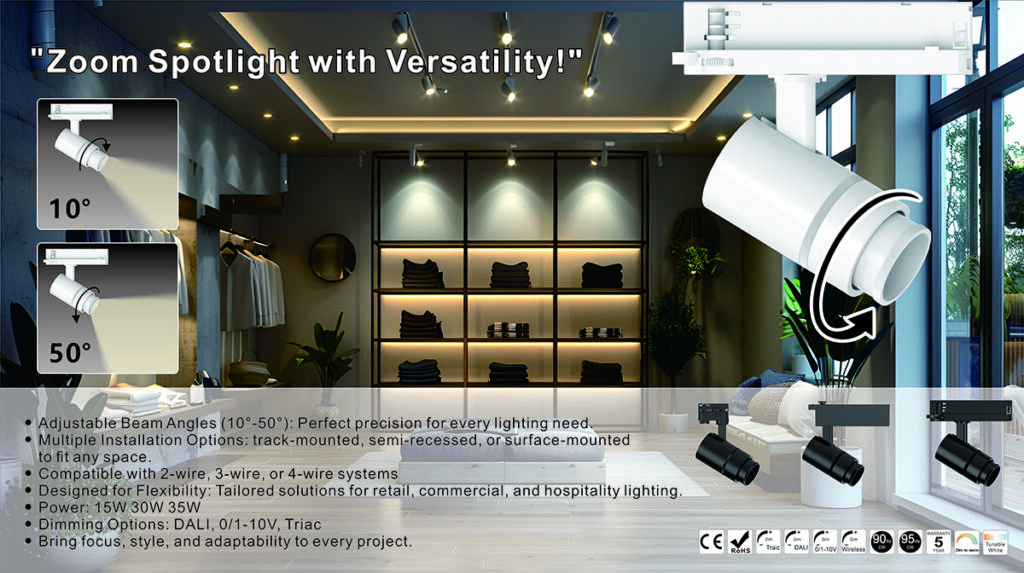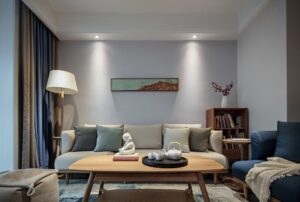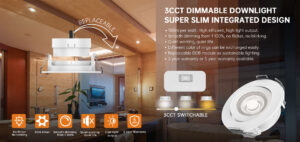When it comes to lighting design, understanding beam angle is crucial for achieving the desired illumination in any space. Whether you’re lighting up a cozy living room, a professional workspace, or an art gallery, the beam angle of your downlights, track lights or spotlights plays a significant role in how light is distributed. But what exactly is beam angle, and how do you calculate it? In this article, we’ll break down everything you need to know about beam angle, its applications, and how to determine the right angle for your lighting needs.
What is Beam Angle?
Beam angle refers to the angle at which light is emitted from a light source, such as a bulb or LED Downlight. It determines the spread of light and how wide or narrow the beam will be when it hits a surface. A smaller beam angle creates a more focused, spotlight like effect, while a larger beam angle produces a wider, more diffused light.
For example:
A 10-degree beam angle is ideal for highlighting specific objects, like artwork or architectural features.
A 60-degree beam angle is better suited for general room lighting, as it covers a larger area.
Understanding beam angle is essential for selecting the right lighting for different applications, whether it’s for task lighting, accent lighting, or ambient lighting.
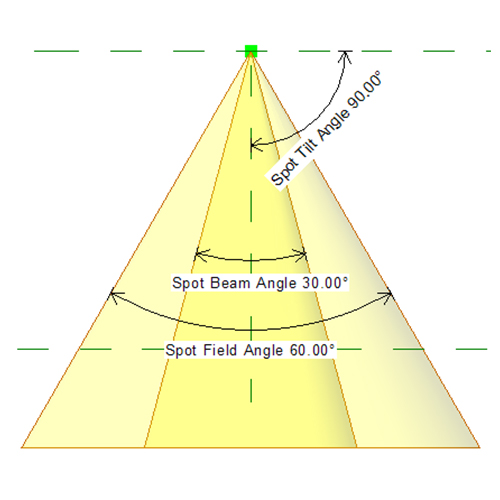
Need Custom Beam Angles?
Radians provides 5°-120° lighting product with 24-hour technical support.
What will affect the beam angle of lamps?
The beam angle is determined by the design of the light fixture and the placement of the light source within it. Here’s how it works:
- Light Source Placement: The position of the LED or bulb within the fixture affects how light is dispersed. A light source placed deeper in the fixture will produce a narrower beam, while one closer to the opening will create a wider beam.
- Reflectors and Lenses: Many fixtures use reflectors or lenses to control the beam angle. Reflectors direct light outward at a specific angle, while lenses can diffuse or focus the light.
- Beam Spread Measurement: The beam angle is measured in degrees, from one edge of the light beam to the other. This is often referred to as the Full Width Half Maximum (FWHM), where the angle is measured at the points where the light intensity is half of its maximum.
Spotlights typically have a narrow beam angle (10°–25°), perfect for focused light on a specific object or feature.
Downlights have a wide beam angle (40°–120°), making them suitable for general lighting in larger spaces.
CIE vs IES Standards: What Buyers Must Know
| Standard | Measurement Point | Typical Use Regions | Conversion Formula |
|---|---|---|---|
| CIE (Europe) | 50% of maximum intensity | EU, Middle East, Asia | IES ≈ 0.6 × CIE |
| IES (North America) | 10% of maximum intensity | USA, Canada | CIE ≈ 1.67 × IES |
Pro Tip: Always confirm the standard when buying LED lights for international projects to avoid under/over-lighting.
Factors Influencing Beam Angle in Lighting Design
Three primary elements shape a fixture’s beam angle:
1. Light Source Positioning
The depth of an LED or bulb within its housing directly impacts light dispersion. For example, recessed fixtures like Radians Lighting’s Ultra Slim Downlights position LEDs deeper, creating narrower beams ideal for task lighting. Conversely, surface-mounted fixtures produce broader spreads.
2. Optical Components
- Reflectors: Parabolic reflectors in track lights, such as Radians’ Dimmable Track Lighting, collimate light into tight beams.
- Lenses: Frosted lenses diffuse light, while clear lenses maintain focus. Radians’ Smart RGB+CW GU10 Bulbs use interchangeable lenses for customizable spreads.
3. Full Width Half Maximum (FWHM)
Beam angles are measured at points where light intensity drops to 50% of its peak. This standardized method ensures consistency across manufacturers.
Beam Angle Classifications: NEMA vs. Standard
| Application | Standard Beam Angle | NEMA Classification |
|---|---|---|
| Spotlighting | 5°–15° | Very Narrow (10°–18°) |
| Retail Displays | 16°–25° | Narrow (18°–29°) |
| Residential Task Lighting | 26°–35° | Medium-Narrow (29°–46°) |
| Office General Lighting | 36°–59° | Medium (46°–70°) |
| Outdoor Floodlighting | 90°–120° | Medium-Wide (70°–100°) |
Step-by-Step Guide to Calculating Beam Angle
- Identify Fixture Specifications
Review manufacturer data for inherent beam angles. For instance, Radians’ Surface Mounted Adjustable Downlight offers a default 30° beam. - Measure Distance and Spread
– Distance (D): From fixture to illuminated surface.
– Diameter (W): Lit area’s width at 50% intensity. - Apply the Arctangent Formula
Beam Angle = 2 × arctan((W/2) ÷ D)Example: For a 4-meter diameter at 3 meters distance:
Beam Angle = 2 × arctan(2 ÷ 3) ≈ 67° - Validate with FWHM Measurements
Use a lux meter to confirm intensity drop-off points.
Practical Applications of Beam Angles
Residential Spaces
- Narrow Beams (15°–30°): Accentuate kitchen countertops or artwork. Radians’ Mini Downlights provide focused task lighting.
- Wide Beams (60°–120°): Illuminate living rooms uniformly with Recessed Downlights.
Commercial and Industrial Settings
- Very Narrow (10°–18°): Highlight merchandise in retail via Track Light Spotlights.
- Medium-Wide (70°–100°): Ensure safety in warehouses with Outdoor LED Wall Lights.
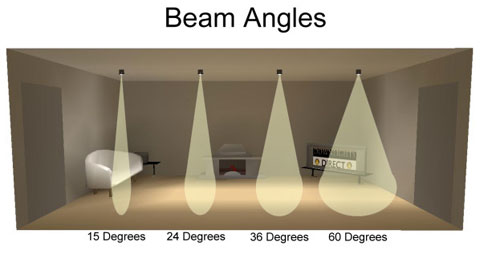
Why Beam Angle Matters
Beam angles are important because they dictate the dispersion of light from a source, affecting the number of lights needed in a space and influencing the final lighting result. The correct beam angle ensures light is directed where needed, enhancing the aesthetics and practical use of any space.
Here’s why beam angles matter:
- Light Distribution: Beam angle affects how light spreads from the source. A narrow beam concentrates light, creating a spotlight effect ideal for highlighting objects or areas. A wide beam disperses light over a broader area, creating even illumination suitable for general lighting.
- Brightness: A narrow beam angle concentrates light into a smaller area, making it appear brighter, whereas a wide beam angle spreads light over a larger area, reducing the intensity.
- Coverage Area: Beam angle determines the area covered by light. Smaller beam angles provide focused light on a specific area, while larger beam angles light up bigger spaces.
- Minimizing Wasted Light: Optimized beam angles ensure light is focused on the intended area, reducing light spillage into unwanted spaces. Using a narrow beam to spotlight an object prevents light from spreading elsewhere.
- Energy Savings: Optimizing beam angles can lead to significant energy savings. For example, using a wider beam angle to uniformly light a large space can reduce the need for multiple light fixtures.
- Glare Control: The right beam angle helps in managing glare, improving visual comfort.
Considering the space and ceiling height is important when selecting a beam angle. In spaces with low ceilings, wider beam angles are often preferred for even light distribution. Conversely, higher ceilings may require narrower beam angles to focus light downwards. The intended use of lighting, whether for task, accent, or general illumination, also determines the appropriate beam angle.
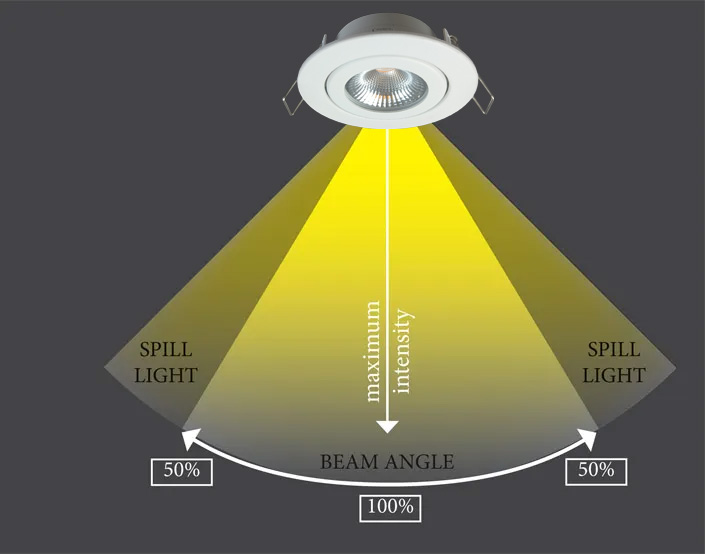
How to caculate beam angle?
Calculating beam angle is essential for precise lighting design. Here’s a step-by-step guide:
Measure the Distance: Determine the distance (D) from the light source to the surface you want to illuminate.
Measure the Diameter: Measure the diameter (W) of the illuminated area on the surface.
Use the Formula: Apply the formula for beam angle (θ):
θ=2×arctan( W/2D)
Where:
θ = Beam angle in degrees
W = Diameter of the illuminated area
D = Distance from the light source to the surface
Example Calculation:
If the diameter of the illuminated area is 4 meters and the distance from the light source is 5 meters:
θ=2×arctan( W/2D)=2×arctan( 4/2×5)=2×arctan(0.4)≈43.6°
This means the beam angle is approximately 44°
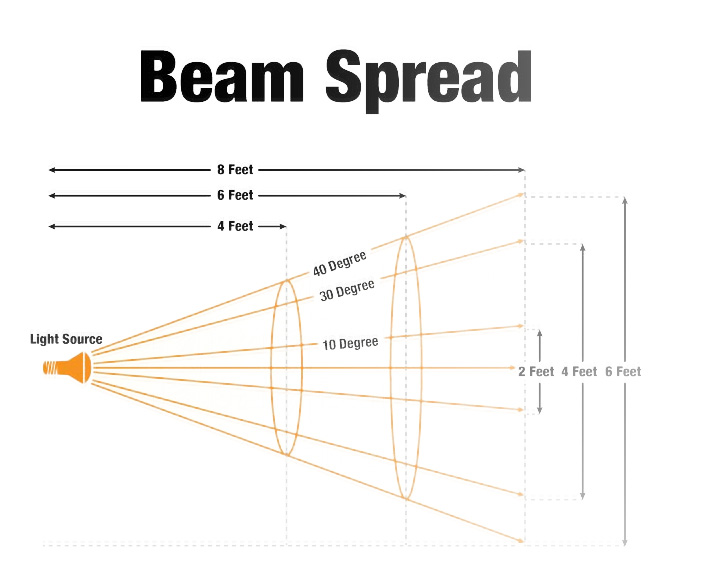
Practical Applications
Consider a retail store looking to highlight a new product display. By using spotlights with a narrow beam angle (e.g., 10-15 degrees), the store can create a focal point, drawing customers’ eyes to the display. Conversely, in an office environment, wide beam angles (e.g., 90-120 degrees) provide uniform lighting, reducing eye strain and improving productivity.
Can I change the beam angle of a lamp?
The answer is YES. Radians has a type of track light with zoomable beam angle. It comes with adjustable beam from 10-50 degree. The features for this item as follows:
- Flexibility: The angle is variable from 10-50°, and you can freely change the angle according to your purpose, irradiate the object more accurately, and change it as you like.
- Compatibility: Compatible with 2-wire, 3-wire, and 4-wire railway system.
- Diversity: There are many designs, suitable for different types of tracks, and can be semi-recessed.
- Dimming: Supports multiple dimming methods, DALI, triac (or ELV), 0-10V/1-10V.
Radians offers a diverse range of lighting solutions beyond the products previously mentioned.
This includes a comprehensive selection of downlights, encompassing models for both indoor and outdoor use, as well as dimmable downlights, anti-glare downlights, and waterproof downlights. These downlights are available with lens or reflector designs and in a variety of beam angles, from narrow to wide.
Radians also provides a variety of track lighting options, including adjustable angle models, suitable for residential spaces like kitchens, living rooms, and bedrooms, as well as commercial applications such as showrooms, museums, and exhibition halls.
For further details on the complete Radians product line, please contact our customer service team by clicking HERE.
Conclusion
Understanding beam angle is key to effective lighting design. Whether you’re illuminating a home, office, or outdoor space, knowing how to calculate and apply beam angle can help you achieve the perfect balance of light and shadow. By selecting the right beam angle, you can enhance functionality, save energy, and create the desired ambiance for any setting.
Ready to put this knowledge into practice? Experiment with different beam angles to see how they transform your space. And if you have any questions or experiences to share, feel free to leave a comment below or CONTACT US directly!
FAQs
1. What is the difference between beam angle and field angle?
Beam angle refers to the angle where the light intensity is at least 50% of its maximum, while field angle is the angle where the intensity drops to 10%. Field angle is always wider than beam angle.
2. What beam angle is best for task lighting?
For task lighting, a narrow beam angle (10°-30°) is ideal as it provides focused light for detailed work.
3. How does beam angle affect energy efficiency?
A narrower beam angle directs light more precisely, reducing wasted light and improving energy efficiency.
4. Are there tools to measure beam angle?
Yes, tools like goniophotometers are used to measure beam angles accurately in professional settings.

